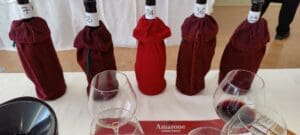Why are there seven dwarfs? Simply because the wine, Don Melchor, is a blend from seven wines with distinct characters. Just like the seven dwarfs from folklore. But before you see the wine and personify it into the dainty, elegant Snow White, Don Melchor is the contrary. There is strength, subtlety, refinement, touch of sophistication and probably an acute precision. At a session I attended, the wines that made up the blend were presented individually. What was the winemaker’s intention?
Since its inception in 1883, Concha y Toro built several relationships with France. Its founder, Don Melchor de Concha y Toro, first planted varieties sourced from Bordeaux with the help of a French enologist. Then a century later, in the 1980s, Mr. Eduardo Guilisasti Tagle, CEO of the company, again engaged the help of renown French professor Émile Peynaud and Jacques Boissenot to launch its first super premium label.
The first attempt to combine Franco-Chilean effort in the twentieth century gave birth to the wine, Don Melchor. And from its first vintage in 1987, the wine quickly rose to stardom. It wasn’t before long when it caught the interest of late Baroness Philippine Rothschild who was then the owner of the illustrious French winery, Château Mouton Rothschild.
This was the third relationship. One that saw these two wineries entered into a joint-venture agreement to create Viña Almaviva, which today stands along Don Melchor as some of the finest wines from Chile.
But the Don Melchor wine couldn’t have made its way to the top simply by namesake. Instead, it was people like Enrique Tirado, the sole winemaker for Don Melchor, who had tirelessly and faithfully played the role of a custodian and servant to the Cabernet Sauvignon vines, and to the Puento Alto vineyard. One of his most significant work was an extensive soil research in 2002 to identify the various parcels that show the best characters he wanted for Don Melchor.
Predominantly made from Cabernet Sauvignon, the wine had seen little changes over the years.
Grapes planted in the 127 hectares vineyard were grouped into seven different parcels; six Cabernet Sauvignon and one Cabernet Franc. Each parcel yielded a different style unique to itself. Nonetheless, it wasn’t difficult to pinpoint the differences, no matter how subtle they were, when tasted side by side. One parcel showed bright, lively juicy weight with a nose that was so ripe it reminded me of a fresh fruit cake. Another showed hint of menthol coupled with sweet oak. Others showed sophistication through deeply layered flavours, interspersed with red and black fruits. Yet after blending them together, the 2013 Don Melchor was clearly a cool climate style which expressed the vintage condition correctly.
The biggest takeaway from the tasting, however, weren’t just about the wines that went into the product, but the possibility, and the ability, of having unique characters differentiated by small geographical differences. Enrique Tirado did not just demonstrated his wines, but proved that Chilean wines were not, and will not be, residing on a two-dimensional plane of existence. There are more than simple, linear variety expressions here.



